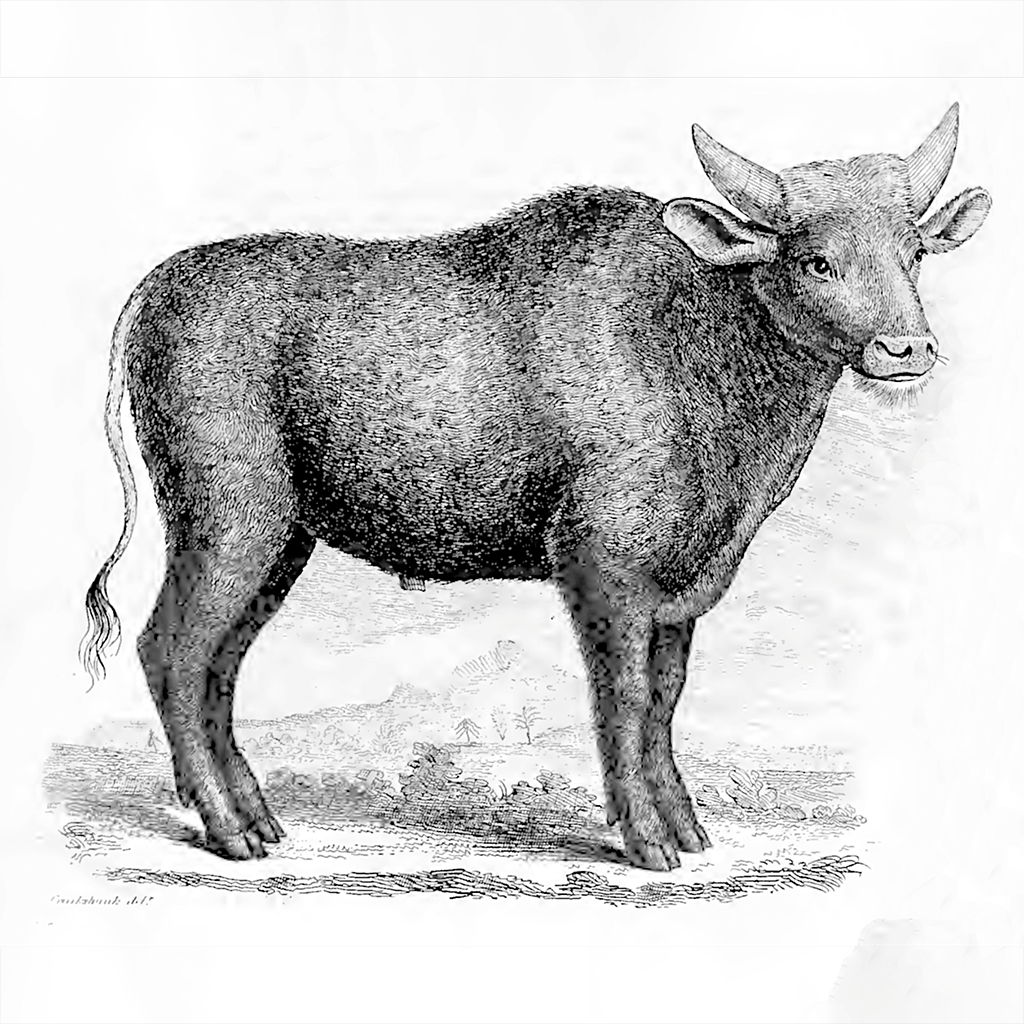Interspecies Mapping and Timing
A View from Mithun Country
DOI:
https://doi.org/10.52537/humanimalia.18820Keywords:
Interspecies history, Bos frontalis, mithun, Himalayas, animal sacrifice, area studiesAbstract
This article argues for an interspecies methodology to challenge the human-derived spatial and temporal constructs that underpin most historical narratives. It also seeks to qualify the entrenched dichotomy between wildness and domestication.
To this end, I focus on the interaction between humans and “mithuns” (Bos frontalis), bulky bovines endemic in the mountain forests of the eastern Himalayas. In this large region—covering parts of India, Myanmar, Bangladesh, Bhutan, and China—numerous societies attuned their cultural sensibilities and cosmological assumptions to the same animal. This remarkable feat of cultural convergence attests to the unwitting power that a semi-wild bovine exerted over generations of humans—a fact that environmental historians can incorporate into their analyses of interspecies agency.
The significance of mithuns to humans had nothing to do with their livestock potential. They were sacred animals that humans needed to communicate with supernatural forces. The form that this communication took was ceremonial sacrifice. During the twentieth century, however, mithun–human relationships morphed into a new sacrality of place, ethnic identity, regional belonging, and political resistance. This transformation suggests the need for an “interspecies periodization” that takes human-nonhuman temporalities seriously.
As most of these societies historically did not use script, written evidence is not plentiful. Therefore, Indigenous forms of knowledge production about the environmental past—embedded in songs, stories, dances, rituals, material remains, dress, and sculptural art—are of paramount importance. These shaped human behaviour towards mithuns in the past, and they continue to do so today.
Downloads
References
Achumi, Ilito H. “‘Tell Them Our Story’: Memories of the Sumi Naga Labour Corps in World War I.” South Asia: Journal of South Asian Studies 46, no. 1 (2023): 55–70. https://doi.org/10.1080/00856401.2023.2143653
Adcock, Cassie, and Radhika Govindrajan. “Bovine Politics in South Asia: Rethinking Religion, Law and Ethics.” South Asia: Journal of South Asian Studies 42, no. 6 (2019): 1095–1107.
“Affairs on the North-East Frontier.” Foreign and Political Department, Secret E Branch, Government of India, Proceedings (December 1914) 156–34. National Archives of India, New Delhi.
Agrawal, Ankush, and Vikas Kumar. Numbers in India’s Periphery: The Political Economy of Government. Cambridge: Cambridge University Press, 2020.
Ahrestani, Farshid S. “Bos frontalis and Bos gaurus (Artiodactyla: Bovidae).” Mammalian Species 50, no. 959 (2018): 34–50. https://doi.org/10.1093/mspecies/sey004
Aisher, Alexander. “Through ‘Spirits’: Cosmology and Landscape Ecology among the Nyishi Tribe of Upland Arunachal Pradesh, Northeast India”. PhD thesis, University College London, 2006.
Aisher, Alexander. “Voices of Uncertainty: Spirits, Humans and Forests in Upland Arunachal Pradesh, India. South Asia: Journal of South Asian Studies 30, no. 3 (2007), 479–98. https://doi.org/10.1080/00856400701714088
Aiyadurai, Ambika. “‘Tigers are our Brothers’: Understanding Human-Nature Relations in the Mishmi Hills, Northeast India.” PhD thesis, University of Singapore, 2016.
Baig, Mumtaz, et al. 2013. “Mitochondrial DNA Diversity and origin of Bos frontalis.” Current Science 104, no. 1 (2013): 115–20.
Barbe, M. “Some Account of the Hill Tribes in the Interior of Chittagong, in a Letter to the Secretary of the Asiatic Society.” Journal of the Asiatic Society of Bengal 14, no. 1 (1845): 380–91.
Bareigts, André. Les Lautu: Contribution à l’étude de l’organisation sociale d’une ethnie chin de Haute-Birmanie. Paris: SELAF, 1981.
Bhattacharya, Neeladri, and Joy L. K. Pachuau, eds. Landscape, Culture, and Belonging: Writing the History of Northeast India. Cambridge: Cambridge University Press, 2019.
Blackburn, Stuart. Himalayan Tribal Tales: Oral Tradition and Culture in the Apatani Valley. Leiden: Brill, 2008.
Blackburn, Stuart. “Oral Stories and Culture Areas: From Northeast India to Southwest China.” South Asia: Journal of South Asian Studies 30, no. 3 (2007): 419–37. https://doi.org/10.1080/00856400701714054
Blench, Roger. “The Contribution of Linguistics to Understanding the Foraging/Farming Transition in Northeast India.” In 50 Years after Daojali-Hading, edited by Tiatoshi Jamir and Manjil Hazarika, 99–109. New Delhi: Research India Press, 2014.
Bonnell, Jennifer, and Sean Kheraj, eds. Traces of the Animal Past: Methodological Challenges in Animal History. Calgary: University of Calgary Press, 2022.
Boomgaard, Peter. Southeast Asia: An Environmental History. Santa Barbara, CA: ABC-CLIO, 2007.
Brauns, Claus-Dieter, and Lorenz G. Löffler. Mru: Hill People on the Border of Bangladesh. Translated by Doris Wagner-Glenn. Basel: Springer Basel.
Butler, John. “Rough Notes on the Angámi Nágás and their Language.” Journal of the Asiatic Society of Bengal 44, no. 1 (1875): 308–46.
Castelló, José R. Bovids of the World: Antelopes, Gazelles, Cattle, Goats, Sheep, and Relatives. Princeton, NJ: Princeton University Press, 2016.
Cederlöf, Gunnel, and Willem van Schendel, eds. Flows and Frictions in Trans-Himalayan Spaces: Histories of Networking and Border Crossing. Amsterdam: Amsterdam University Press, 2022.
Chakrabarti, Ranjan, ed. Critical Themes in Environmental History of India. New Delhi: Sage, 2020.
Chen, Yan, Tianlu Zhang, Ming Xian, et al. “A Draft Genome of Drung Cattle Reveals Clues to Its Chromosomal Fusion and Environmental Adaptation.” Communications Biology 5 (2022): 353. https://doi.org/10.1038/s42003-022-03298-9
Cram, Dominic L., Jessica E. M. van der Wal, Natalie T. Uomini, et al. “The Ecology and Evolution of Human–Wildlife Cooperation.” People and Nature 4, no. 4 (2022): 841–55. https://doi.org/10.1002/pan3.10369
Cuvier, Frédéric. Supplément à l’histoire naturelle générale et particulière de Buffon. Vol. 1: Mammifères. Paris: F. D. Pillot, 1831.
Das, Debojyoti. “From Millet to Rice: The Politics of the New Faith and Time Discipline among Borderland Communities in Eastern Nagaland.” Asian Ethnology 79, no. 2 (2020): 377–94.
Devi, Ningthoujam Neelima, Bihsal Dahar, Prasanta Kumar Bera, Yashmin Choudhury, and Sankar Kumar Ghosh. “Revisit of the Taxonomic Status of Bos Genus with Special Reference to North Eastern Hilly Region of India.” Animal Gene 27 (2023): 200143. https://doi.org/10.1016/j.angen.2022.200143
Dinerstein, Eric, David Olson, Anup Joshi, et al. “An Ecoregion-Based Approach to Protecting Half the Terrestrial Realm.” BioScience 67, no. 6 (2017): 534–45. https://doi.org/10.1093/biosci/bix014
Dorji, Tashi, Jigme Wangdi, Yi Shaoliang, Nakul Chettri, and Kesang Wangchuk. “Mithun (Bos frontalis): The Neglected Cattle Species and Their Significance to Ethnic Communities in the Eastern Himalaya — A Review.” Animal Bioscience 34, no. 11 (2021): 1727–38. https://doi.org/10.5713/ab.21.0020
Dulong Niu [Mithun]. [Lushui]: People’s Government of Nujiang Lisu Autonomous Prefecture, Yunnan, 2023.
Elwin, Verrier. Myths of the North-East Frontier of India. New Delhi: Munshiram Manoharlal, 1958.
Evans, G.P. Big-Game Shooting in Upper Burma. London: Longmans, Green, 1911.
Faruque, M.O., et al. “Present Status of Gayal (Bos frontalis) in the Home Tract of Bangladesh.” Bangladesh Journal of Animal Science 44, no. 1 (2015): 75–84. https://doi.org/10.3329/bjas.v44i1.23147
Fisher, Michael H. An Environmental History of India: From Earliest Times to the Twenty-First Century. Cambridge: Cambridge University Press, 2018.
Fraser, David W., and Barbara G. Fraser. Mantles of Merit: Chin Textiles from Myanmar, India and Bangladesh. Bangkok: River Books, 2005.
Fürer-Haimendorf, Christoph von. The Konyak Nagas: An Indian Frontier Tribe. New York and London: Holt, Rinehart and Winston, 1969.
Geng, Yanfei, Guoxiong Hu, Sailesh Ranjitkar, et al. “Prioritizing Fodder Species Based on Traditional Knowledge: A Case Study of Mithun (Bos frontalis) in Dulongjiang Area, Yunnan Province, Southwest China.” Journal of Ethnobiology and Ethnomedicine 13 (2017): 24. https://doi.org/10.1186/s13002-017-0153-z
Gros, Stéphane. “Cultes de fertilité chez les Drung du Yunnan (Chine)”. Moussons 19 (2012): 111–136. https://doi.org/10.4000/moussons.1264
He, Zhan Xing, Yoko Sato, Ji Cai Zhang, et al. “Superovulatory Response and Pregnancy after Interspecies Transfer of Embryos in Semi-wild Dulong (Bos frontalis) — Short Communication.” Veterinarski Arhiv 84, no. 2 (2014), 183–88. https://hrcak.srce.hr/119052
Head, W. R. Hand Book on the Haka Chin Customs. Rangoon: Office of the Superintendent, Government Printing, Burma, 1917.
Hill, Christopher V. South Asia: An Environmental History. Santa Barbara, CA: ABC-CLIO, 2008.
Hutton, J. H. Diaries of Two Tours in the Unadministered Area East of the Naga Hills. Calcutta: Baptist Mission Press, 1929.
ICAR-National Research Centre on Mithun. Management Practices for Improved Mithun (Bos frontalis) Husbandry. Medziphema, Nagaland: ICAR-NRC on Mithun, 2020. https://nrcmithun.icar.gov.in/node/704
ICAR-National Research Centre on Mithun. Mithun (Bos frontalis): The Unique Bio-Resource of North East India. Medziphema, Nagaland: ICAR-NRC on Mithun, 2020. https://nrcmithun.icar.gov.in/node/701
ICAR-National Research Centre on Mithun. “Semi-intensive Mithun Rearing Units.” Mithun Digest 17, no. 1 (2021): 14. https://nrcmithun.icar.gov.in/node/909
Iqbal, Iftekhar. “Fighting with a Weed: Water Hyacinth and the State in Colonial Bengal, c. 1910–1947.” Environment and History 15, no. 1 (2009): 35–59. https://doi.org/10.3197/096734009X404653
Jackson, Kyle. The Mizo Discovery of the British Raj: Empire and Religion in Northeast India, 1890–1920. Cambridge: Cambridge University Press, 2023.
Kabir, Shariear. “A Report on Case Study of a Gayal Farm Located at Padua, Sukhbilash Rangunia, Chattogram.” Chattogram: Chattogram Veterinary and Animal Sciences University, 2020. http://dspace.cvasu.ac.bd/jspui/handle/123456789/451
Kauffmann, Hans-Eberhard. “Landwirtschaft bei den Bergvölkern von Assam und Nord-Burma.” Zeitschrift für Ethnologie 66, no. 1/3 (1934): 15–111. https://www.jstor.org/stable/25839470
Kauffmann, Hans-Eberhard. “Die Bedeutung des Dorftores bei den Angami-Naga.” Geographica Helvetica 10, no. 2 (1955): 84–95. https://doi.org/10.5194/gh-10-84-1955
Kean, Hilda, and Philip Howell, eds. The Routledge Companion to Animal–Human History. London: Routledge, 2019.
Khan, Meraj Haider, et al. Semi-Intensive Mithun Farming: Success Stories Under Tribal Sub Plan (2016–2021). Medziphema, Nagaland: ICAR-National Research Centre on Mithun, 2022.
King, Ben, and Julian P. Donahue. “The Rediscovery and Song of the Rusty-Throated Wren Babbler Spelaeornis badeigularis”. Forktail no. 22 (2006): 113–15.
Krutak, Lars. “Neo-Naga.” TätowierMagazin July 2015: 50–54.
Lambert, Aylmer Bourke. “Description of Bos Frontalis, a new Species, from India.” Transactions of the Linnean Society 7, no. 1 (1804): 57–59. https://doi.org/10.1111/j.1096-3642.1804.tb00280.x
Lambert, Aylmer Bourke. “Further Account of the Bos Frontalis.” Transactions of the Linnean Society 7, no. 1 (1804): 302–5. https://doi.org/10.1111/j.1096-3642.1804.tb00296.x
LaPolla, Randy J., and David Sangdong. Rawang-English-Burmese Dictionary (A Tibeto-Burman Language Spoken in Myanmar). Singapore: privately published, 2015. https://www.rawang.org/files/Rvwang-English-Burmese%20dictionary.pdf
Lehman, F. K. The Structure of Chin Society: A Tribal People of Burma Adapted to a Non-Western Civilization. Urbana: University of Illinois Press, 1963.
Li, S. P., H. Chang, G. L. Ma, and H. Y. Cheng. “Molecular Phylogeny of the Gayal in Yunnan China Inferred from the Analysis of Cytochrome b Gene Entire Sequences.” Asian-Australasian Journal of Animal Science 21, no. 6 (2008): 789–93. https://doi.org/10.5713/ajas.2008.70637
Li, Yan, et al. “Large-Scale Chromosomal Changes Lead to Genome-Level Expression Alterations, Environmental Adaptation, and Speciation in the Gayal (Bos frontalis).” Molecular Biology and Evolution 40, no. 1 (2023). https://doi.org/10.1093/molbev/msad006
Longkumer, Arkotong. “Representing the Nagas: Negotiating National Culture and Consumption.” In Bhattacharya and Pachuau, Landscape, Culture, and Belonging, 151–75.
Lotha, Abraham. The Raging Mithun: Challenges of Naga Nationalism. Kohima: Barkweaver, 2013.
Ma, Jun, et al. “Comparative Transcriptome Analyses of Gayal (Bos frontalis), Yak (Bos grunniens), and Cattle (Bos taurus) Reveal the High-Altitude Adaptation.” Frontiers in Genetics 12 (2022): 778788. https://doi.org/10.3389/fgene.2021.778788
Macrae, John. “Account of the Kookies or Lunctas.” Asiatic Researches 7 (1803): 183–98.
Malsawmliana. “Socio-Economic Importance of Sial (Mithun) in Traditional Mizo Society.” Historical Journal Mizoram 21 (2021): 41–53.
Mayirnao, Shaokhai, and Sinalei Khayi. “Decolonising Feasts of Merit: Reasoning Marān Kasā from a Tangkhul Naga Perspective”. Asian Ethnicity 24, no. 2 (2023): 258–77. https://doi.org/10.1080/14631369.2022.2089093
Mills, J. P. The Ao Nagas. London: Macmillan, 1926.
Mittermeier, Russell A., Will R. Turner, Frank W. Larsen, Thomas M. Brooks, and Claude Gascon. “Global Biodiversity Conservation: The Critical Role of Hotspots.” In Biodiversity Hotspots: Distribution and Protection of Conservation Priority Areas, edited by Frank E. Zachos, and Jan Christian Habel, 3–22. Heidelberg: Springer, 2011.
Miyamoto, Mari, Jan Magnusson, and Frank J. Korom. “Animal Slaughter and Religious Nationalism in Bhutan.” Asian Ethnology 80, no. 1 (2021): 121–45.
Morrison, Kathleen D. “Conceiving Ecology and Stopping the Clock: Narratives of Balance, Loss, and Degradation.” In Shifting Ground: People, Animals, and Mobility in India’s Environmental History, edited by Mahesh Rangarajan and K. Sivaramakrishnan, 39–60. New Delhi: Oxford University Press, 2014.
Mukherjee, Sabyasachi, Anupama Mukherjee, Sanjeev Kumar, et al. “Genetic Characterization of Endangered Indian Mithun (Bos frontalis), Indian Bison/Wild Gaur (Bos gaurus) and Tho-tho Cattle (Bos indicus) Populations Using SSR Markers Reveals Their Diversity and Unique Phylogenetic Status.” Diversity 14, no. 7 (2022): 548. https://doi.org/10.3390/d14070548
Norton, Marcy. The Tame and the Wild: People and Animals after 1492. Cambridge, MA: Harvard University Press, 2024.
Pachuau, Joy L.K., and Willem van Schendel. The Camera as Witness: A Social History of Mizoram, Northeast India. Delhi: Cambridge University Press, 2015.
Pachuau, Joy L.K., and Willem van Schendel. Entangled Lives: Human-Animal-Plant Histories of the Eastern Himalayan Triangle. Cambridge: Cambridge University Press, 2022.
Passah, Sajeki. Pnar–English Dictionary. Jowai: Pnar Printers and Publishers, 2013.
Pearson, J. T. “Memorandum on the Gaur and Gayal.” Journal of the Asiatic Society of Bengal 6, no. 1 (1837): 225–30.
Perlin, Ross. “A Grammar of Trung.” Himalayan Linguistics (2020). https://doi.org/10.5070/H918244579
Post, Mark. W. “On Reconstructing Ethno-linguistic Prehistory: The Case of Tani.” In Crossing Boundaries: Tibetan Studies Unlimited, edited by Diana Lang, Jarmila Ptáčková, Marion Wettstein, and Mareike Wulff, 311–40. Prague: Academia, 2022.
Project Maje. “Mithuns Sacrificed to Greed: The Forest Ox of Burma’s Chins.” Portland, OR: Project Maje, 2004. https://www.projectmaje.org/mithuns.htm
Rai, Prabhat Kumar, and M. Muni Singh. “Lantana camara Invasion in Urban Forests of an Indo-Burma Hotspot Region and Its Ecosustainable Management Implication through Biomonitoring of Particulate Matter.” Journal of Asia-Pacific Biodiversity 8, no. 4 (2015): 375–81. https://doi.org/10.1016/j.japb.2015.09.003
Rainey, R. M. “Notes on the Chinboks, Chinbons, and Yindus of the Chin Frontier of Burma.” Indian Antiquary 21 (1892): 215–24.
Rangarajan, Mahesh, and K. Sivaramakrishnan, eds. India’s Environmental History from Ancient Times to the Colonial Period: A Reader. 2 vols. Ranikhet: Permanent Black, 2012.
Rangarajan, Mahesh, and K. Sivaramakrishnan, eds. Shifting Ground: People, Animals, and Mobility in India’s Environmental History. Oxford: Oxford University Press, 2014.
Rawlins, John. “On the Manners, Religion, and Laws of the Cucis, or Mountaineers of Tipra.” Asiatic Researches 2 (1799): 187–93.
Roscher, Mieke, André Krebber, and Brett Mizelle, eds. Handbook of Historical Animal Studies. Berlin: de Gruyter, 2021.
Sakhong, Lian H. In Search of Chin Identity: A Study in Religion, Politics and Ethnic Identity in Burma. Copenhagen: NIAS Press, 2003.
Sarma, Abhishruti, and Joseph Zoliana. Changing Affinities: Ecologies of Human–Mithun Relationships in Northeast India. Guwahati: North Eastern Social Research Centre, 2023.
Shakespear, John. “The Lushais and the Land They Live In.” Journal of the Society of Arts 43, no. 2201 (January 1895): 167–185. https://www.jstor.org/stable/41334168
Shakespear, L. W. History of the Assam Rifles. London: Macmillan, 1929.
Sharma, H. Surmangol. Learners’ Manipuri–English Dictionary. Imphal: Sangam Book Store, 2006.
Simoons, Frederick J., and Elizabeth S. Simoons. A Ceremonial Ox of India: The Mithan in Nature, Culture and History. Madison: University of Wisconsin Press, 1968.
Singh, U Nissor. Khasi–English Dictionary. Shillong: Eastern Bengal and Assam Secretariat Press, 1906.
Smyer Yü, Dan. “Situating Environmental Humanities in the New Himalayas: An Introduction.” In Smyer Yü and De Maaker, Environmental Humanities in the New Himalayas, 1–24.
Smyer Yü, Dan. “Environmental Edging of Empires, Chiefdoms, and States: Corridors as Transregions.” In Smyer Yü and Dean, Yunnan–Burma–Bengal Corridor Geographies, 46–67.
Smyer Yü, Dan, and Erik de Maaker, eds. Environmental Humanities in the New Himalayas: Symbiotic Indigeneity, Commoning, Sustainability. London: Routledge, 2021.
Smyer Yü, Dan, and Karin Dean, eds. Yunnan–Burma–Bengal Corridor Geographies: Protean Edging of Habitats and Empires. London: Routledge, 2022.
Swart, Sandra. “Animals in African History.” In Oxford Research Encyclopedia of African History, edited by Thomas T. Spear. Oxford: Oxford University Press, 2019. https://doi.org/10.1093/acrefore/9780190277734.013.443
Tenzin, Sangay, Jigme Dorji, Tashi Dorji, and Yoshi Kawamoto. “Assessment of Genetic Diversity of Mithun (Bos frontalis) Population in Bhutan Using Microsatellite DNA Markers.” Animal Genetic Resources 59 (2016): 1–6. https://doi.org/10.1017/S2078633616000072
Tzüdir, Lanusangla. “Appropriating the Ao Past in a Christian Present.” In Bhattacharya and Pachuau, Landscape, Culture, and Belonging, 265–93.
Uzzaman, Rasel, Shamsul Alam Bhuiyan, Zewdu Edea, and Kwan-Suk Kim. “Semi-domesticated and Irreplaceable Genetic Resource Gayal (Bos frontalis) Needs Effective Genetic Conservation in Bangladesh: A Review.” Asian-Australasian Journal of Animal Science 27, no. 9 (2014): 1368–72. http://doi.org/10.5713/ajas.2014.14159
Van der Wal, Jessica E. M., Claire N. Spottiswoode, Natalie T. Uomini, Mauricio Cantor, Fábio G. Daura-Jorge, Dominic L. Cram, et al. “Safeguarding Human–Wildlife Cooperation.” Conservation Letters 15, no. 4 (2022): e12886. https://doi.org/10.1111/conl.12886
Van Schendel, Willem. “Non-Human Labour History? Three Short Questions.” Notebooks: The Journal for Studies on Power 2, no. 2 (2023): 189–99. https://doi.org/10.1163/26667185-bja10035
Van Schendel, Willem, Wolfgang Mey, and Aditya Kumar Dewan. The Chittagong Hill Tracts: Living in a Borderland. Bangkok: White Lotus Press, 2000.
Wang, Ming-Shan, Yan Zeng, Xiao Wang, et al. “Draft Genome of the Gayal, Bos frontalis.” GigaScience 6, no 11 (2017). https://doi.org/10.1093/gigascience/gix094
Weckerle, Caroline S., Yongping Yang, Franz K. Huber, and Qiaohong Li. “People, Money, and Protected Areas: The Collection of the Caterpillar Mushroom Ophiocordyceps sinensis in the Baima Xueshan Nature Reserve, Southwest China”. Biodiversity and Conservation 19 (2010): 2685–98. https://doi.org/10.1007/s10531-010-9867-0
Wilcox, R. “Memoir of a Survey of Asam and the Neighbouring Countries, Executed in 1825-6-7-8.” Asiatic Researches 17 (1832): 314–469.
Woodward, Mark R. “Gifts for the Sky People: Animal Sacrifice, Headhunting and Power among the Naga of Burma and Assam.” In Indigenous Religions: A Companion, edited by Graham Harvey, 219–29. London: Cassell, 2000.
Wouters, Jelle J. P. 2021. “Relatedness, Trans-species Knots and Yak Personhood in the Bhutan Highlands.” In Smyer Yü and De Maaker, Environmental Humanities in the New Himalayas, 27–42.
Yekha-ü and Queenbala Marak. “Elicüra: The ‘Feasts of Merit’ Shawl of the Chakhesang Naga of Northeast India.” The Oriental Anthropologist 21, no. 1 (2021): 138–57. https://doi.org/10.1177/0972558X21990790
Yumlam Tana. “Let’s Hope Anyway.” NetLit Review: The Seven Sisters Post Literary Review, 3 June 2012. https://nelitreview.tumblr.com/post/24306633566/poems-by-yumlam-tana

Published
Issue
Section
License
Copyright (c) 2024 Willem van Schendel (Author)

This work is licensed under a Creative Commons Attribution 4.0 International License.









